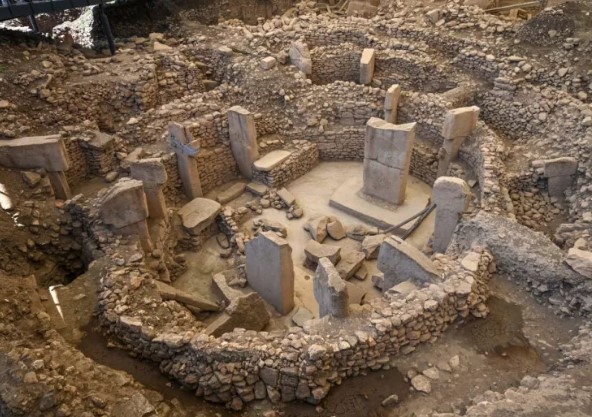Gobekli Tepe, an ancient archaeological site located in southern Turkey, has long intrigued researchers with its complex structures and carvings. Among these carvings, a series of V-shaped symbols has recently caught the attention of scientists, leading to some groundbreaking discoveries. At first glance, these symbols might seem unremarkable compared to the more elaborate depictions of animals and celestial bodies nearby. However, upon closer examination, these V-shaped marks could hold the key to understanding one of humanity’s earliest attempts to track time and record a significant event in history.
Researchers have proposed that these symbols might represent the world’s oldest lunisolar calendar. A lunisolar calendar is a calendar that tracks both the moon’s phases and the sun’s position throughout the year. This kind of calendar would have been crucial for ancient people who relied on the cycles of nature for agriculture and survival. The presence of such a calendar at Gobekli Tepe suggests that the people who lived there were not only skilled in constructing massive stone pillars but were also keen observers of the sky. Their understanding of the celestial cycles might have been far more advanced than previously thought.
Evidence of a Catastrophic Event
The discovery of the V-shaped symbols has also led to a fascinating theory about a catastrophic event that might have shaped the course of human history. According to the researchers, these carvings might not just represent the passage of days or months but could be a record of a dramatic event that took place around 13,000 years ago. This event is believed to be a comet strike that caused widespread destruction on Earth, leading to a mini ice age that lasted for about 1,200 years.
Astounding Disappearance: Saturn’s Fading Rings
The theory suggests that the inhabitants of Gobekli Tepe were trying to record the date when a swarm of comet fragments hit the Earth. This event, which occurred around 10,850 BC, had a massive impact on the planet’s climate and ecosystems. It is believed to have caused the extinction of many large animals, such as mammoths and steppe bison, that roamed the Earth during the Pleistocene epoch. The sudden change in climate, with temperatures dropping rapidly, would have been a life-altering event for the people living at that time.
The idea that these ancient people were trying to make sense of such a catastrophic event is both intriguing and poignant. It suggests that they were not just passive victims of this disaster but were actively trying to understand and document what had happened. The V-shaped symbols could be seen as an early form of writing, a way for these ancient observers to record a momentous event in their history.
Strange Discovery: Dark Oxygen Baffles Scientists
Impact on Early Civilization
The potential connection between the comet strike and the development of early civilization is a topic of much interest and debate among scientists. Some researchers believe that this catastrophic event might have been a catalyst for significant changes in human society. The sudden onset of colder temperatures and the resulting challenges in finding food and shelter could have driven people to innovate and adapt in new ways. This period of struggle might have led to the development of new technologies, agricultural practices, and even religious beliefs.
The idea that a disaster could lead to the birth of civilization is a powerful one. It suggests that in the face of overwhelming challenges, humans are capable of remarkable resilience and creativity. The people of Gobekli Tepe, faced with the devastation caused by the comet strike, may have sought to understand the forces that shaped their world. Their observations of the sky, recorded in the form of these V-shaped symbols, might have been part of an effort to make sense of the chaos around them.
Startling Dam: Did A Massive Structure In China Alter Earth’s Rotation?
The findings at Gobekli Tepe offer a glimpse into a time when humans were beginning to develop the tools and knowledge that would eventually lead to the rise of complex societies. The possibility that these symbols represent the world’s oldest lunisolar calendar and a record of a comet strike is a testament to the ingenuity and curiosity of our ancient ancestors. While much about Gobekli Tepe remains shrouded in mystery, the recent discoveries have provided valuable insights into the minds of the people who built this remarkable site.




